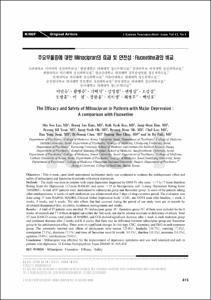주요우울증에 대한 Milnacipran의 효과 및 안전성:Fluoxetine과의 비교
- Keimyung Author(s)
- Kim, Jung Bum
- Department
- Dept. of Psychiatry (정신건강의학)
- Journal Title
- 신경정신의학
- Issued Date
- 2004
- Volume
- 43
- Issue
- 4
- Keyword
- Milnacipran; Fluoxetine; Efficacy; Safety
- Abstract
- Objectives:This 6-week, open
label randomized, multicenter study was conducted to evaluate the antidepressant effect and
safety of milnacipran and fluoxetine in patients with major depression.
Methods:The study was done in patients with major depression diagnosed by DSM-IV who score ≥17 in 17 items Hamilton
Rating Scale for Depression (17-item HAM-D) and score ≥25 in Montgomery and Åsberg Depression Rating Scale
(MADRS). A total of 87 patients were randomized to milnacipran group and fluoxetine group. In cases of the patients taking
other antidepressants, 6 weeks of each medication was administered after 7 days of drug excretion period. The evaluation was
done using 17 item HAM-D, MADRS, Clinical Global Impression Scale (CGI), and COVI scale after baseline, 1 week, 2
weeks, 4 weeks, and 6 weeks. The side effects that had occurred during the period of our study were put in records by
developed/disappeared time, severities, incidences, managements and results.
Results:A total of 87 patients were enrolled. 70 (milnacipran group 39;fluoxetine group 31) of them were included for the 6
weeks of research and 17 of them dropped out within the first week, not due to adverse reactions or deficiency of effects. Total
17 item HAM-D scores, total points of MADRS, and CGI showed significant decrease after 1 week in each treatment group
and continued decrease after 2 weeks and 4, 6 weeks. But there was no difference between milnacipran group and fluoxetine
group in the antidepressant effect. There were no significant changes in vital sign, CBC, chemistry, and EKG in each treatment
group. The commonly reported side effects of minlacipran were nausea (25.0%), headache (10.7%), vomiting (7.1%),
constipation (7.1%), dizziness (7.1%) and those of fluoxetine were GI trouble (11.1%), diarrhea (11.1%), insomnia (11.1%),
agitation (5.6%), and dizziness (5.6%).
Conclusion:Milnacipran was effective for the improvement of depressive symptoms and was well tolerated and safe in
patients with depression.
- Alternative Title
- The Efficacy and Safety of Milnacipran in Patients with Major Depression:A comparison with Fluoxetine
- Keimyung Author(s)(Kor)
- 김정범
- Publisher
- School of Medicine
- Citation
- 이민수 et al. (2004). 주요우울증에 대한 Milnacipran의 효과 및 안전성:Fluoxetine과의 비교. 신경정신의학, 43(4), 415–424.
- Type
- Article
- ISSN
- 1015-4817
- Appears in Collections:
- 1. School of Medicine (의과대학) > Dept. of Psychiatry (정신건강의학)
- 파일 목록
-
-
Download
 oak-bbb-4744.pdf
기타 데이터 / 493.24 kB / Adobe PDF
oak-bbb-4744.pdf
기타 데이터 / 493.24 kB / Adobe PDF
-
Items in Repository are protected by copyright, with all rights reserved, unless otherwise indicated.